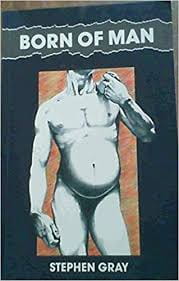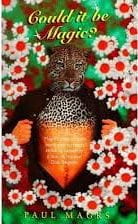Born of Man and Could It Be Magic?: a summary of my central texts in Ch. 3—two books published by gay male authors through queer presses, dealing with gay men becoming impregnated and giving birth to biological children.
 “It’s my observation that the one thing every male gay I know wants most, and can never have, is a child.”1
“It’s my observation that the one thing every male gay I know wants most, and can never have, is a child.”1
So states the narrator of Stephen Gray’s 1989 novel Born of Man. This work of queer magical realism follows the narrator through networks of queer families and communities in AIDS-era, apartheid South Africa. While commenting on a wide range of topics within race and sexuality, the central narrative of this work follows the tumultuous relationship between the introverted but flashy clothing designer Kevin and rebellious biker Henno. Their narrative is one that follows a long line of stereotypically tragic queer romances in literature, with gay, effeminate Kevin seeking out the abuse that Henno provides.
Their affair begins on a cross-country road trip that ends as Kevin is found tied up in a sketchy motel room, gagged and abandoned, with the first four letters of “MOFFIE” cut into his back. While initially being portrayed as a kind of hate act, an account of internalized homophobia made corporeal on Henno’s part, he later explains that he had only done what Kevin had asked of him. Kevin calmly admits the truth of Henno’s claim, saying he’d not only wanted it but “wanted it to hurt” (39). A confused Henno laters recalls worrying about disappointing Kevin, saying, “He wanted that so all the world would know even a moffie could have a child” (113). This narrative thus shifts from being portrayed as a hate act to become something more like what Heather Love describes as “feeling backwards”—a reflex to gay liberation, an acknowledgement of “feelings of shame, secrecy, and self-hatred [that] are still with us.”2 According to Love, “Rather than disavowing such feelings as the sign of some personal failing, we need to understand them as indications of material and structural continuities between these two eras” (21). Born of Man operates as both a recording of this history as well as an exploration of it, an idea that will resurface near the end of this chapter (or in a later blog post).
Despite Henno’s disbelief, however, Kevin does in fact bear a child in Born of Man. After the cancer-ridden Fiona (the only substantial female character in the novel) becomes impregnated by Henno, she decides to transfer the fetus to Kevin, who—quick to volunteer—finds himself the first pregnant man. The details of this procedure and the ensuing pregnancy are mapped out in detail over the next hundred pages: the fetus is implanted rectally, is expected to continue growing indefinitely, and so requires a c-section delivery. Despite referring to Kevin and Henno as the child’s dads, many of the dynamics in the parents’ relationship is structured by gendered stereotypes. Much as with the narratives described by Shulamith Firestone (to be addressed in Ch. 2 of my dissertation), the birth of Kevin and Henno’s baby results in Kevin’s loss of interest in Henno, which he invests in the newborn instead: “The child is Kev’s sole preoccupation, and Henno, who used to be the centre, became the periphery, and then irrelevant. I suppose this is many a mother’s and father’s experience—nature’s way of ensuring a reliable support-system for the child” (180).
While Kev’s child is the central image of reproductive futurity in this text, various strands of queer cultural inheritance and gay male family making surface throughout the story. As the narrator comments on his own writing experience in typing out Kevin’s narrative on his new word processor, his fascination with creative generativity runs alongside the larger repronarrative.3 “In the beginning was the Word, and the Word was Processed,” he states, and—in so doing—unites man’s creative abilities and the novel’s depiction of man’s procreation with Judeo-Christian account of man’s creation (141). Meanwhile, the narrator also conducts an affair with a young, male sex worker—a bizarre and extended encounter that illustrates why Stephen Gray’s writing has been likened to Kurt Vonnegut’s—that leads him to reflect on intergenerational relationships between queer men as a surrogate form of parenting.
 Less than a decade after the publication of Born of Man, another text of queer magical realism arrived in the form of the second offering in Paul Magr’s Phoenix Court trilogy, Could It Be Magic?, which also centered on a child born to two biological parents, both male.4 Many of the dynamics in this story mirror those in Gray’s novel, with Andy—a gay man—becoming impregnated by Mark—a bisexual one. Some of the gendered stereotypes are here, too, reproduced as Andy, the effeminate and bookish bottom in the couple, also hides his pregnancy (although less intentionally than Kevin hid his) from his overtly masculine counterpart. One key difference, however, is that Magrs’s novel depicts Andy having a child by unsuspected, though natural means, unaided by medical interventions. Whereas Kevin is the willful surrogate to another’s child, Andy is impregnated through anal sex with Mark and, despite the changes he observes in his body, remains unaware of his pregnancy until he gives birth to his child on the bathroom floor of an Edinburgh gay bar. Some other key differences in this narrative can be located in the details of the pregnancy and the child itself. Whereas Born of Man explains the events of Kevin’s pregnancy in terms of “natural” processes and medical discourse, Could It Be Magic? represents Andy’s pregnancy in mythopoeic terms, giving birth—not to an entirely human child, but one who has the head and face of a leopard—from a growth on his calf (reflecting Dionysus’s birth from Zeus’s thigh), which he then cuts open to deliver his child. Thus, Mark and Andy’s child not only offers a narrative for queer family making (in line with Stephen Gray’s novel), but it also connects to a wider range of the repro lit in this genre in which queer modes of reproduction lead to “monstrous” offspring. Although Magrs’s “leopard boy” isn’t represented in overly-horrific terms (he is regarded as an abomination, an animal, a wonder…), a clear lineage emerges connecting this work to Victorian monsters, perhaps most readily notable through links to Wells’s vivisected animal-human hybrids in Dr. Moreau.
Less than a decade after the publication of Born of Man, another text of queer magical realism arrived in the form of the second offering in Paul Magr’s Phoenix Court trilogy, Could It Be Magic?, which also centered on a child born to two biological parents, both male.4 Many of the dynamics in this story mirror those in Gray’s novel, with Andy—a gay man—becoming impregnated by Mark—a bisexual one. Some of the gendered stereotypes are here, too, reproduced as Andy, the effeminate and bookish bottom in the couple, also hides his pregnancy (although less intentionally than Kevin hid his) from his overtly masculine counterpart. One key difference, however, is that Magrs’s novel depicts Andy having a child by unsuspected, though natural means, unaided by medical interventions. Whereas Kevin is the willful surrogate to another’s child, Andy is impregnated through anal sex with Mark and, despite the changes he observes in his body, remains unaware of his pregnancy until he gives birth to his child on the bathroom floor of an Edinburgh gay bar. Some other key differences in this narrative can be located in the details of the pregnancy and the child itself. Whereas Born of Man explains the events of Kevin’s pregnancy in terms of “natural” processes and medical discourse, Could It Be Magic? represents Andy’s pregnancy in mythopoeic terms, giving birth—not to an entirely human child, but one who has the head and face of a leopard—from a growth on his calf (reflecting Dionysus’s birth from Zeus’s thigh), which he then cuts open to deliver his child. Thus, Mark and Andy’s child not only offers a narrative for queer family making (in line with Stephen Gray’s novel), but it also connects to a wider range of the repro lit in this genre in which queer modes of reproduction lead to “monstrous” offspring. Although Magrs’s “leopard boy” isn’t represented in overly-horrific terms (he is regarded as an abomination, an animal, a wonder…), a clear lineage emerges connecting this work to Victorian monsters, perhaps most readily notable through links to Wells’s vivisected animal-human hybrids in Dr. Moreau.
In her analysis of Magrs’s text, Emma Parker reflects Jack Halberstam directly and Stephen Gray’s narrator indirectly, as she points to the mythic claim that “it is universal to want a child, it is only human to want to give birth.” 5 As with many other examples in reproduction lit, this narrative views Andy’s child as providing him with the love and companionship he was unable to find elsewhere, in friends, family, or romantic relationships. In this way, biological modes of family making are represented in both of these novels as a means for queer folks (gay men, specifically) to find what is otherwise seen as unattainable—a sense of belonging, a sense of purpose, a sense of security.
The publication of both of these novels, written by gay male writers and released through niche LGBT publishers in the UK and the U.S., coincide within what Liz Montegary regards as a historical moment marked by increased interest, visibility and advocacy for family equality for and by queer parents. Acknowledging that family equality advocacy extends as far back as a century, Montegary also notes that it is “a rather new cultural phenomenon, […] a product of the ‘gayby boom’ of the late 1980s and 1990s.”6 And while Montegary further states that “the LGBT family has received remarkably little attention,” both Magrs and Gray’s texts offer one means of exploring both the current climate for queer family making and its future trajectory. To understand how the novels’ portrayals of queer families enters into queer theory discourse surrounding the pros and cons of LGBT family rights and advocacy, one must first grasp the antisocial turn (or the antisocial thesis) of queer theory… to be addressed in the next post.
- Stephen Gray. Born of Man. GMP, 1989, p. 142. ↩
- Heather Love, Feeling Backwards. Harvard University Press, 2007. ↩
- A term coined by Michael Warner to identify the prevalent convention in early American texts to structure narratives around traditional forms of marriage and reproduction. Warner, Michael. “Irving’s Posterity.” ELH, vol. 67, no. 3, Sept. 2000, pp. 773–99. Project MUSE, doi:10.1353/elh.2000.0029. ↩
- Paul Magrs. Could It Be Magic?. Lethe Press, 1998. ↩
- Emma Parker, “Male Pregnancy and Queer Utopia in Paul Magrs’s Could it be Magic?,” Textual Practice 28.6 (2014), pp. 1035-1056, p. 1044. ↩
- Liz Montegary. Familiar Perversions. Rutgers University Press, 2018, p. 5. ↩
Leave a Reply